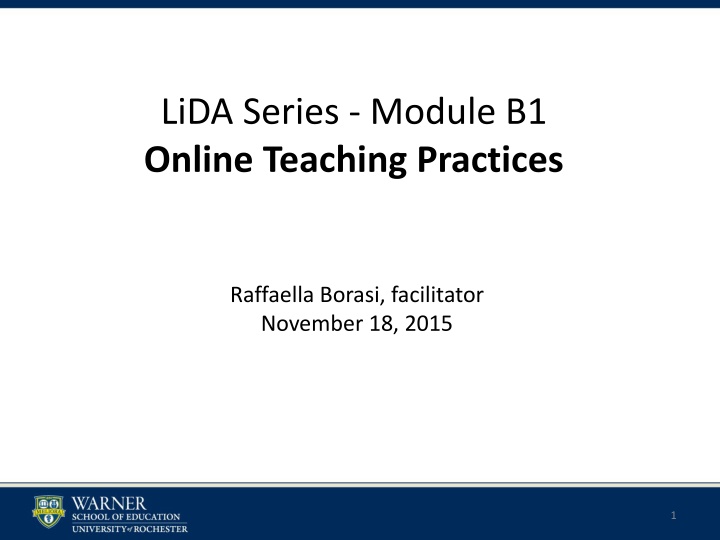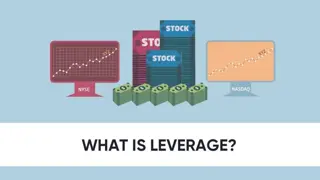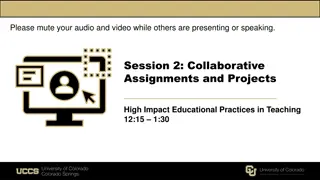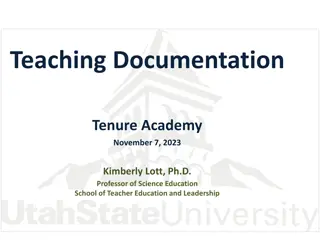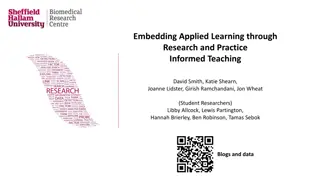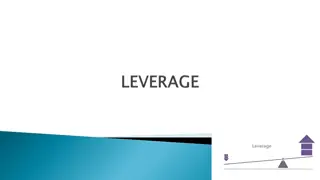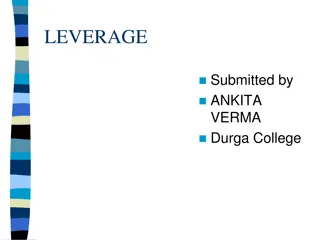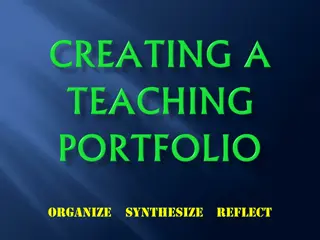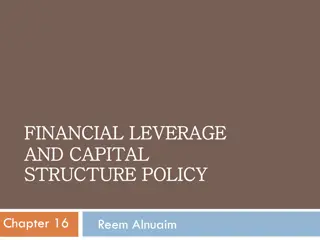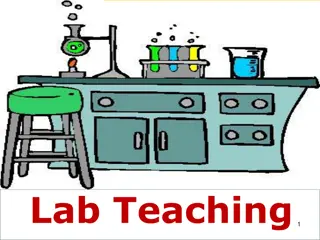High-Leverage Online Teaching Practices: Research and Examples
Delve into the exploration of high-leverage online teaching practices in teacher education, focusing on key definitions, assumptions, and examples. Understand the impact of proficiently executed practices on student learning across diverse contexts and age levels.
Download Presentation

Please find below an Image/Link to download the presentation.
The content on the website is provided AS IS for your information and personal use only. It may not be sold, licensed, or shared on other websites without obtaining consent from the author.If you encounter any issues during the download, it is possible that the publisher has removed the file from their server.
You are allowed to download the files provided on this website for personal or commercial use, subject to the condition that they are used lawfully. All files are the property of their respective owners.
The content on the website is provided AS IS for your information and personal use only. It may not be sold, licensed, or shared on other websites without obtaining consent from the author.
E N D
Presentation Transcript
LiDA Series - Module B1 Online Teaching Practices Raffaella Borasi, facilitator November 18, 2015 1
Agenda Essential question: What are high-leverage online teaching practices and how can they best be developed? Framing: Research on high-leverage teaching practices Anchoring/ shared example: Learning high-leverage online teaching practices in EDE484 Discussing: Group discussion at tables Sharing Connecting: Implications for you (your work/research) Looking Ahead 2
FRAMING Highlights of research on high-leverage teaching practices in teacher education 3
Framing Key Definitions Teaching practice = actions that teachers do habitually or routinely to support learning High-leverage teaching practices (HLTP) = a core set of practices that have the greatest impact on student learning Micro-practice = specific component/aspects of a teaching practice that need to be learned to enact the practice effectively (From Hlas & Hlas, 2012) 4
Framing Examples of HLTPs Appraising, choosing and modifying tasks and texts for a specific goal Designing a sequence of lessons towards a specific learning goal Leading a whole class discussion Setting up and managing small group work Eliciting and interpreting individual students thinking Providing oral and written feedback to students on their work Implementing organizational routines, procedures and strategies to support a learning environment (From current TeachingWorks website, 2015) 5
Framing Key Assumptions High-leverage teaching practices, when executed proficiently, increase the likelihood that teaching will promote student learning across a broad range of content, contexts and age levels (CAVEAT: not clear how the set of HLTP is identified and if everyone agrees) NOTE: This is counter to a view of teaching as improvisational, uncertain, and impervious to specification (Ball & Forzani, 2009) For novice teachers, learning to execute a small set of high-leverage teaching practices proficiently can be the best return on investment There are more and less effective ways for novice teachers to learn to enact high-leverage teaching practices 6
Framing Key Features of HLTPs 1. 2. Effective in advancing students learning Effective in using and managing student differences, and in confronting inequities Useful across many contexts, content, and age levels Can be assessed Serve as building blocks for learning practice Can be unpacked and taught to beginners Can be justified and made convincing to teacher candidates (and others) as meaningful and useful for becoming skilled practitioners Are unlikely to be learned well only through experience 3. 4. 5. 6. 7. 8. (Adapted from Hlas & Hlas, 2012) 7
Framing Key Features of HLTPs 1. 2. Effective in advancing students learning Effective in using and managing student differences, and in confronting inequities Useful across many contexts, content, and age levels Can be assessed Serve as building blocks for learning practice Can be unpacked and taught to beginners Can be justified and made convincing to teacher candidates (and others) as meaningful and useful for becoming skilled practitioners Are unlikely to be learned well only through experience 3. 4. 5. 6. 7. 8. (Adapted from Hlas & Hlas, 2012) 8
Framing Example of unpacking micro-practices Leading a discussion: 1. Launching the discussion/purpose setting 2. Using students ideas to advance the discussion 3. Eliciting, scaffolding and following up students contributions 4. Managing multiple ideas 5. Making public records of the discussion (selecting ideas to be recorded; re- voicing original contributions) 6. Using language that is accurate yet accessible to students 7. Identifying and highlighting the core of an idea/explanation 8. Working with students errors and misconceptions 9. Clarifying terms 10. Asking students to ground discussion in shared knowledge and terms 11. Engaging different students equitably 12. Deploying and connecting representations of content (Adapted from Hlas & Hlas, 2012) 9
Framing Example of unpacking micro-practices Leading a discussion: 1. Launching the discussion/purpose setting 2. Using students ideas to advance the discussion 3. Eliciting, scaffolding and following up students contributions 4. Managing multiple ideas 5. Making public records of the discussion(selecting ideas to be recorded; re- voicing original contributions) 6. Using language that is accurate yet accessible to students 7. Identifying and highlighting the core of an idea/explanation 8. Working with students errors and misconceptions 9. Clarifying terms 10. Asking students to ground discussion in shared knowledge and terms 11. Engaging different students equitably 12. Deploying and connecting representations of content (Adapted from Hlas & Hlas, 2012) 10
Framing Teaching HLTPs Training to help teachers learn a specific HLTP should include: 1. Seeing examples of the HLTP in practice 2. Learning to dissect and analyze these examples 3. Practicing the HLTP under close supervision and with coaching (Adapted from Ball & Forzani, 2009) 11
ANCHORING Focus on high-leverage online teaching practices in EDE484: Online Teaching and Learning 12
Anchoring Context EDE484 key goals: Empowering novice online teachers to design and implement high quality online modules in their field BY: Learning fundamental principles about motivation, learning, teaching, assessment and instructional design - and their application to online education Learning to use essential tools and technologies (mostly within BB) Learning about a few key online teaching practices Engaging in scaffolded experiences of designing and implementing online modules 13
Anchoring Selected Online HLTP Online teaching practices explicitly studied in EDE484: 1. Introducing new online tools 2. Providing directions for independent work 3. Conveying content online 4. Sharing students work online 5. Orchestrating online discussions 6. Synthesizing learning 14
Anchoring Learning Specific Online HLTP Set of learning activities around each online teaching practice: Experience as learner possibly more than one experience Reflections on the experiences as learners (F2F and online) Synthesis document Using the online teaching practice as appropriate in the design and/or implementation of their online modules Current focus: Identifying potential benefits and limitations/concerns Becoming aware of key implementation decisions/options, and pros and cons of each Identify general implementation tips 15
Anchoring An illustration OHLTP: Options within Conveying content online Alternative ways to convey content online: Instructor-created: video of lecture; Panopto recording; narrated Powerpoint; synchronous mini-lecture ; home-made animation Published materials: articles/chapters; webpages; video/documentary; published animation Alternative ways to engage students with the content: Providing information/instructional about how to read Online (low-stakes) quizzes Discussion boards related to the readings Online assignments related to the readings 16
Anchoring Open Questions 1. Of the online teaching practices identified so far, which ones are truly high-leverage (and why)? Are we missing some other high-leverage online teaching practices? Does our approach to developing high-leverage online teaching practices seem reasonable? What else could we do to develop effectively a specific high-leverage online teaching practice? 2. 3. 17
DISCUSSING At your table address the Essential Question OR any of the questions below: Of the online teaching practices identified so far, which ones are truly high-leverage (and why)? Are we missing some other high-leverage online teaching practices? Does our approach to developing high-leverage online teaching practices seem reasonable? What else could we do to develop effectively a specific high-leverage online teaching practice? Sharing of highlights will follow
CONNECTING Going around the room, each person can take a turn (or pass, if they d prefer) to share a connection they see between what we ve discussed and their own work, research, personal interests in Learning in the Digital Age
LOOKING AHEAD What s on Blackboard Follow-up discussion on this topic during the next LiDA session: December 2 Next study session essential question: What impact could MOOCs have on the future of education?
